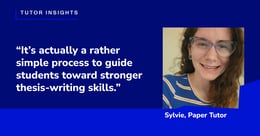
3 ways to support overwhelmed students (Clone)
In addition to studying core subjects, students learn a lot of valuable life skills in K-12—including how to handle stress. Find out how Paper™ tutor Marie-Eve supports students as they build confidence.
As tutors who have gone through college or university, we know all too well how stressful school life can be, with its piles of homework and readings spread out amongst exams and other obligations.
As adults, however, we’ve had years to develop strategies to get us through tough assignments and overwhelming classes. With this knowledge under our belts, it’s sometimes easy to forget that many students haven’t had these experiences. And as Paper tutors, it’s an important fact we should keep at the front of our minds.
Students—and particularly younger ones—may not always let us know that they’re feeling overwhelmed or that they don’t understand the material we’re reviewing. This stress can come out in the form of “I don’t know” responses to our inquiry-based questions, pushing for answers, or becoming frustrated and seemingly impatient with tutors.
[READ: “The IDK session: What causes students to lack confidence?”]
Adapting to students’ needs while remaining encouraging and empathetic can help tutors navigate a stressful session. This can also result in a more positive outcome for the student.
Taking a step back
When students come to Paper for help, it’s likely because they already tried solving the challenging problem or concept on their own—and were left feeling as though they don’t know any of the material at all. In my tutoring experience, however, it’s usually pretty likely that these learners at least know something about the topic they’re studying.
Growing up with an undiagnosed learning disability, I understood most of my class material just fine; however, I found certain instruction methods difficult to follow along with or that I needed a bit of extra guidance from a teacher to nudge me in the right direction. As a child, I would have been quick to respond with an “I don’t know” if asked an overly broad or vague homework question.
Here at Paper, we meet students where they are and help them focus on what they already know. In turn, this helps us focus on expanding students’ existing knowledge. For example, a student may come to a Live Help session confused about a question surrounding the relationship between the Industrial Revolution and the American economy. They will respond with “I don’t know” when asked what they think the answer might be. The student is clearly frustrated and ready to give up.
As a tutor, I help the student take a step back by first breaking down the problem into smaller chunks. What does the student know about the Industrial Revolution? What impacts did it have on individuals or society? Did it make work such as agriculture easier or harder? Asking questions—all while staying patient and uplifting—can help boost a student’s confidence once they realize they know more than they think. All of this can help a student reach that crucial understanding of the class material.
Staying positive and professional
As a Paper tutor, it’s tempting to rush in and help a student when we see they’re struggling—particularly when they’re getting agitated and impatient. We want to “fix” the problem in front of us and ease the student’s distress.
Students, especially younger ones, may not understand why we can’t simply give them the answer. Regardless, tutors recognize that short-term solutions do not lead to long-term learning; by giving students the answer, these learners don’t gain the ability to think critically or understand their own thought processes.
This is where remaining respectful—while still being encouraging—is so important! A stressed-out student who comes to the virtual classroom may not be in the best mindset to begin understanding Paper’s inquiry-based method. Tutors recognize that students are young, establishing an understanding of boundaries, and are likely already under pressure when they log in to Paper.
As Paper tutors, we gently (but firmly) set appropriate boundaries: that we’re here to help students collaboratively, and that we understand they’re worried about their assignments. We can encourage the student to take a short break and, once they’re more calm, explain the Paper Method. I like to describe this process to the student at the very beginning of our interaction: “Can you share with me your class notes or your teacher’s instructions for the assignment? This will help me understand what you’re learning in class so I can best help you out!”
Even when handling potentially difficult interactions, we remain uplifting and positive. We’re quick to celebrate small successes—especially when the student has been struggling for a large portion of the session.
As a tutor, I like to rely on emojis and exclamation points where appropriate. For example, once a student has shared their notes, I can respond: “Thank you for sharing that with me! :-) What have you tried so far while solving this problem?” Being kind and patient can go a long way toward helping an overwhelmed student feel accepted and more at ease.
Leading with empathy
Staying patient and positive is impossible without an empathetic, open-minded approach. Paper’s mission of providing equitable access to academic support relies on tutors’ ability to understand that no two students are alike, and that not all students come to the platform with the same privileges and backgrounds. Some students may struggle with a learning disability. Others might not have a quiet and stress-free environment in which to complete their homework or could face other stressors at home or school that make things overwhelming.
Paper’s tutors don’t assume that all students “should” understand certain material—we meet students where they are and are ready to adapt our tutoring session where it’s needed. If a student prefers to use our whiteboard function to communicate, we encourage them by using it, too. If a student learns better when we share examples, we provide similar questions or concepts to help them understand the subject matter.
When I first read through the student’s question, I like to ask them what they’ve tried so far or what ideas they might have on how to solve the problem. This gives me an idea of what the student has tried and what has or hasn’t worked for them already!
Most importantly, though, we remember that on the other side of the screen is a real, living student. How would we have wanted an adult to treat us when we were upset or swamped with schoolwork? When students tell me “I don’t know” or “I’m so lost,” I remind them that it’s OK to feel stressed—that it's a perfectly normal response when we encounter something challenging! I tell them that we as Paper tutors are here to help, and that we’ll figure out the problem together. More times than not, this helps students relax; they understand that we won’t become impatient or frustrated with them for struggling.
Final thoughts
In this post, we’ve examined three key ways to help and support students: breaking the problem into smaller, more manageable expectations; staying upbeat and patient when students are struggling; and above all else, remaining empathetic and understanding that all students’ needs and backgrounds will differ.
By keeping these three points in mind, Paper tutors not only curb students’ stress during Live Help sessions, but also make them more likely to come back to Paper for future help—and to boost their long-term learning!

Marie-Eve, Paper Tutor
Paper supports students and educators in school districts by providing unlimited, 24/7, and multilingual Live Help and Review Center support.
Who are our tutors?

.png?width=260&height=136&name=Blog-Tutor-Insights-Niya%20(1).png)


.png?width=260&height=136&name=Blog-Tutor-Insights-Kenna%20(1).png)

